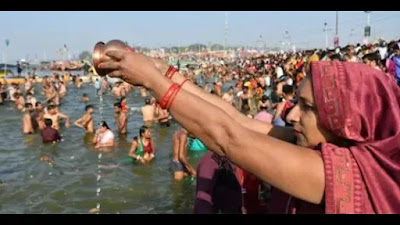 |
| Devotees at the juncture of the Yamuna and Ganges river Adnan Abidi/Reuters |
 |
| Naga Sadhus with trishul at 2013 Maha Kumb Mela Photo by Adnan Abidi, Reuters |
 | |||
| Drone shot of the Sangam area ahead of the Mahakumbh 2025 |
Kapil Dixit in the Times of India explains that the Mela will be protected by a "network of 2,751 CCTV cameras, including 328 AI-enabled cameras" and stationery and underwater drones.
 |
| Devotees take a dip in the Ganga at Prayagraj (HT File Photo) |
- Conduct 5,00,000 free eye tests to screen for vision problems and eye diseases.
- Deploy an expert team of 500 ophthalmologists to offer specialized diagnostics and consultations.
- Distribute 3,00,000 spectacles to individuals needing refractive corrections.
- Engage 1,000 optometrists to ensure smooth execution of the initiative.
- Perform 50,000 eye surgeries for individuals suffering from severe vision impairments, including cataracts and other critical eye conditions.
As always, I welcome your corrections (or praise) and any other input.
“CSR News: World’s Largest Free Eye Check-Up Camp in Mahakumbh 2025 (January 17, 2025), CSR Journal, https://thecsrjournal.in/corporate-social-responsibility-csr-news-worlds-largest-free-eye-check-up-camp-in-mahakumbh-2025/
Dash, Nivedita (November 20, 2024), India TV, https://www.indiatvnews.com/uttar-pradesh/mahakumbh-2025-1-249-km-long-network-of-pipes-to-provide-water-supply-updates-2024-11-20-962557
Dixit, Kapil (January 11, 2025), “10,000 sanitation workers to make Kumbh clean & green,” https://timesofindia.indiatimes.com/india/10000-sanitation-workers-to-make-kumbh-clean-green/articleshow/117134518.cms
Dixit, Kapil (January 13, 2025), “From AI cams to drones, Kumbh Mela site a fortress with 7-ring security,” https://timesofindia.indiatimes.com/india/with-seven-ring-security-sangam-turns-into-fortress/articleshow/117181725.cms
“Maha Kumbh 2025: Seven-ring security plan turns Prayagraj’s Sangam into a fortress” (January 13, 2025), The Economic Times, https://economictimes.indiatimes.com/news/india/maha-kumbh-2025-seven-ring-security-plan-turns-prayagrajs-sangam-into-a-fortress/articleshow/117198758.cms
“Mahakumbh-2025: Three-tier security for entry to mela area ahead of New Year” (December 26, 2024), Hindustan Times, https://www.hindustantimes.com/cities/lucknow-news/mahakumbh2025-three-tier-security-for-entry-to-mela-area-ahead-of-new-year-101735224176483.html
Memish ZA, Steffen R, White P, Dar O, Azhar EI, Sharma A, Zumla A. (May 18, 2019), “Mass gatherings medicine: public health issues arising from mass gathering religious and sporting events.” The Lancet. (10185):2073-2084. doi: 10.1016/S0140-6736(19)30501-X. PMID: 31106753; PMCID: PMC7159069. https://pmc.ncbi.nlm.nih.gov/articles/PMC7159069/#tbl1
Pandey, Geeta, (January 12, 2025), "Millions start bathing in holy rivers at India's biggest Hindu festival, BBC, https://www.bbc.com/news/articles/cvg7gzzx3gno
“PM Modi recalls 1954 Kumbh Mela stampede at election rally in UP (May 1, 2019), The Economic Times, https://economictimes.indiatimes.com/news/elections/lok-sabha/india/pm-modi-recalls-1954-kumbh-mela-stampede-at-election-rally-in-up/articleshow/69129977.cms?from=mdr
Rawat, Anjali (January 7, 2025), “State-Of-The-Art Healthcare For Maha Kumbh 2025: Ensuring Pilgrim Safety, Outlook, https://www.outlookindia.com/brand-studio/state-of-the-art-healthcare-for-maha-kumbh-2025-ensuring-pilgrim-safety
Sheikh Saaliq (January 14, 2024), “Millions of pilgrims and naked, ash-smeared ascetics take holy dips in India’s mega Hindu festival, AP, https://apnews.com/article/india-maha-kumbh-hinduism-527170e00730b5e2a61a70b7423493ad
Saigal, Gaurav (January 11, 2025), “Mahakumbh-2025: Two months of action later, Ganga water fit for holy dip,” Hindustan Times, https://www.hindustantimes.com/cities/lucknow-news/mahakumbh2025-two-months-of-action-later-ganga-water-fit-for-holy-dip-101736612105117.html
Sharma, Shivani (January 6, 2025), “Prayagraj chalo: Khalistani terrorist Pannun threatens to disrupt Mahakumbh,” India Today, https://www.indiatoday.in/india/story/prayagraj-chalo-khalistani-terrorist-gurpatwant-singh-pannun-threatens-to-disrupt-mahakumbh-2025-magh-mela-2660303-2025-01-06
Sukheja, Bhavya (Dec. 21, 2024), NDTV, Maha Kumbh 2025: Know History, Location, Significance And More, NDTV, https://www.ndtv.com/feature/maha-kumbh-2025-know-history-location-significance-and-more-7302358b
“Water quality of Ganga in UP deteriorating due to discharge of sewage: NGT” (November 9. 2024), The Economic Times, https://economictimes.indiatimes.com/news/india/water-quality-of-ganga-in-up-deteriorating-due-to-discharge-of-sewage-ngt/articleshow/115112215.cms?utm_source=contentofinterest&utm_medium=text&utm_campaign=cppst
Clip Art Sources
Kumbh welcome opening image, Maha Kumbh 2025: Know History, Location, Significance And More, NDTV,Kumbh.gov.in https://www.ndtv.com/feature/maha-kumbh-2025-know-history-location-significance-and-more-7302358b
Devotees take a dip in the Ganga at Prayagraj, Hindustan Times, https://www.hindustantimes.com/cities/lucknow-news/mahakumbh2025-two-months-of-action-later-ganga-water-fit-for-holy-dip-101736612105117.html
Naga Sadhus with trishul at 2013 Maha Kumb Mela Photo by Adnan Abidi, Reuters https://www.reuters.com/news/picture/naga-sadhus-idINRTR3D6PA/
Maja Kumbh Mela devotees: Rawat, Anjali (January 7, 2025), “State-Of-The-Art Healthcare For Maha Kumbh 2025: Ensuring Pilgrim Safety, Outlook, https://www.outlookindia.com/brand-studio/state-of-the-art-healthcare-for-maha-kumbh-2025-ensuring-pilgrim-safety
A drone shot of the Sangam area ahead of the Mahakumbh 2025, Dixit, Kapil (January 13, 2025), “From AI cams to drones, Kumbh Mela site a fortress with 7-ring security,” https://timesofindia.indiatimes.com/india/with-seven-ring-security-sangam-turns-into-fortress/articleshow/117181725.cms
Sharp Sight Eye Hospitals at Kumbh Mela, “CSR News: World’s Largest Free Eye Check-Up Camp in Mahakumbh 2025 (January 17, 2025), CSR Journal, https://thecsrjournal.in/corporate-social-responsibility-csr-news-worlds-largest-free-eye-check-up-camp-in-mahakumbh-2025/




No comments:
Post a Comment